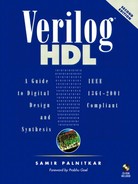From a modest beginning in early 1984 at Gateway Design Automation, the Verilog hardware description language has become an industry standard as a result of extensive use in the design of integrated circuit chips and digital systems. Verilog came into being as a proprietary language supported by a simulation environment that was the first to support mixed-level design representations comprising switches, gates, RTL, and higher levels of abstractions of digital circuits. The simulation environment provided a powerful and uniform method to express digital designs as well as tests that were meant to verify such designs.
There were three key factors that drove the acceptance and dominance of Verilog in the marketplace. First, the introduction of the Programming Language Interface (PLI) permitted users of Verilog to literally extend and customize the simulation environment. Since then, users have exploited the PLI and their success at adapting Verilog to their environment has been a real winner for Verilog. The second key factor which drove Verilog's dominance came from Gateways paying close attention to the needs of the ASIC foundries and enhancing Verilog in close partnership with Motorola, National, and UTMC in the 1987-1989 time-frame. The realization that the vast majority of logic simulation was being done by designers of ASIC chips drove this effort. With ASIC foundries blessing the use of Verilog and even adopting it as their internal sign-off simulator, the industry acceptance of Verilog was driven even further. The third and final key factor behind the success of Verilog was the introduction of Verilog-based synthesis technology by Synopsys in 1987. Gateway licensed its proprietary Verilog language to Synopsys for this purpose. The combination of the simulation and synthesis technologies served to make Verilog the language of choice for the hardware designers.
The arrival of the VHDL (VHSIC Hardware Description Language), along with the powerful alignment of the remaining EDA vendors driving VHDL as an IEEE standard, led to the placement of Verilog in the public domain. Verilog was inducted as the IEEE 1364 standard in 1995. Since 1995, many enhancements were made to Verilog HDL based on requests from Verilog users. These changes were incorporated into the latest IEEE 1364-2001 Verilog standard. Today, Verilog has become the language of choice for digital design and is the basis for synthesis, verification, and place and route technologies.
Samir's book is an excellent guide to the user of the Verilog language. Not only does it explain the language constructs with a rich variety of examples, it also goes into details of the usage of the PLI and the application of synthesis technology. The topics in the book are arranged logically and flow very smoothly. This book is written from a very practical design perspective rather than with a focus simply on the syntax aspects of the language.
This second edition of Samir's book is unique in two ways. Firstly, it incorporates all enhancements described in IEEE 1364-2001 standard. This ensures that the readers of the book are working with the latest information on Verilog. Secondly, a new chapter has been added on advanced verification techniques that are now an integral part of Verilog-based methodologies. Knowledge of these techniques is critical to Verilog users who design and verify multi-million gate systems.
I can still remember the challenges of teaching Verilog and its associated design and verification methodologies to users. By using Samir's book, beginning users of Verilog will become productive sooner, and experienced Verilog users will get the latest in a convenient reference book that can refresh their understanding of Verilog. This book is a must for any Verilog user.
Prabhu GoelFormer President of Gateway Design Automation
